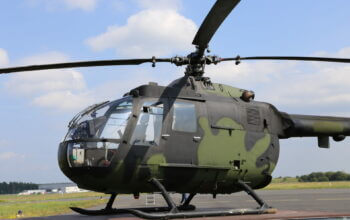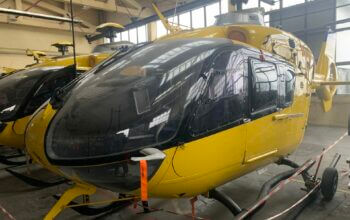Estimated reading time 7 minutes, 56 seconds.
Negotiations could begin as early as this week between the Canadian government and Lockheed Martin for the acquisition of 88 F-35A Lightning II fighter jets.
Public Services and Procurement Canada (PSPC) announced Monday it will enter into what it termed the “finalization phase” of a procurement process with the U.S. defense manufacturer for a fleet of aircraft to replace the Royal Canadian Air Force (RCAF) CF-188 Hornets.
Negotiations, however, do not mean a done deal, said Filomena Tassi, Minister of PSPC. “I want to be clear that this is not a final contract. There is still work to do before a contract can be awarded.”

As part of the finalization phase negotiations, Lockheed Martin and the U.S. government will have to demonstrate that the F-35 can meet Canada’s requirements, “including value for money, flexibility, protection against risks, and performance and delivery assurances, as well as high-value economic benefits for Canada’s aerospace and defence industry,” she said.
“If these items cannot be finalized with the top-ranked bidder, Canada has the right to move to the next ranked bidder.”
The F-35A was the top-ranked bidder, ahead of Sweden’s Saab Gripen E. The Boeing F/A-18E/F Super Hornet was also in the running until December 2021, when it was officially dropped from the competition.
The process to replace the RCAF’s Hornet fleet was first launched by the Conservative government in 2010 when it announced its intention to acquire 65 F-35A aircraft through a sole-source contract. The process was paused in 2012 over concerns about a lack of transparency in the costing and the quality of other potential bidders. The Liberal government relaunched a formal process in 2017 that attracted five interested suppliers, including Airbus and Dassault, and released a request for proposals to those eligible suppliers in July 2019. It closed at the end of July 2020.
Tassi said government officials “diligently” analyzed the proposals to “determine the next steps.” And the recommendation to move to a “finalization” discussion with the top-ranked bidder rather than enter a competitive dialogue process with the final two contenders was unanimous by the 13 evaluation teams at the departments of National Defence, Innovation, Science and Economic Development, and PSPC.
Ministers did not know the final ranking until the morning of March 28, prior to the announcement, she said.
As part of the evaluation, the bids were evaluated against typical RCAF mission scenarios for NATO and NORAD operations. “That factored very fundamentally into the outcome of the process,” said Troy Crosby, Assistant Deputy Minister (Materiel).
The government expects to complete the negotiation with Lockheed Martin within the next seven months, said Tassi. “This is a highly complex process. It is the most significant investment in the RCAF in more than 30 years and it is a cornerstone of Canada’s defense policy.”
Both Tassi and Minister of National Defence, Anita Anand, emphasized on multiple occasions that the process was “open, fair and competitive,” and involved both an independent fairness monitor and a third-party reviewer to “assess the quality and effectiveness of the procurement approach.” Tassi said the 13 evaluation teams awarded points for each bid separately and did not “communicate among themselves” how those points were awarded.

In its 2017 defense policy, the government earmarked $19 billion for the fighter replacement project. Anand said “more accurate details on costing will be further refined” during the negotiations with the manufacturer.
The announcement comes at a time when many are questioning Canada’s defence spending. The government spends about 1.4 percent of GDP on defense, below the NATO target of two percent, and is forecast to reach about 1.48 percent by 2024-25. The future fighter is costed within the current defense policy.
In July 2021, Switzerland bet on the F-35’s affordability when it selected the jet as its new fighter, stating that the F-35 is cheaper than the competition on all fronts, and that it beats them all on capability, too. The F-35 was competing against the Boeing Super Hornet, Dassault Rafale, and Eurofighter Typhoon.
Then, in December 2021, Finland selected the F-35 for its HX Fighter Program, stating it is the “most advanced, survivable, and connected fighter aircraft in the world.”
Though Canada’s Liberal government would appear to have reached the same conclusion as the Conservatives about the quality of the F-35A, Tassi said the rigorous procurement process “allowed competitive bidders to put their best foot forward. . . . As we move forward, we can say this [decision] was based on evidence, based on facts. It’s not based on speculation or guesses.”
Canada is one of eight original members in the Joint Strike Fighter Program, a participant in the development phase since 1997 that has generated opportunities for the defense aerospace industry in the F-35 supply chain. From 1997 to December 2021, Canada invested a total of US$613 million in the F-35.
Delivery of the first future fighter aircraft is expected by 2025. The RCAF has not discussed publicly which operational fighter squadron could be first to receive the jets, but the government said investments were already well underway at both main operating bases – 4 Wing Cold Lake, Alberta, and 3 Wing Bagotville, Quebec – to upgrade infrastructure. In 2020, a $9.2-million contract was awarded to EllisDon for the design of a new fighter jet facility at 4 Wing while a $12.1-million contract went to EllisDon-EBC Inc. Joint Venture for the design of a new facility at 3 Wing.








